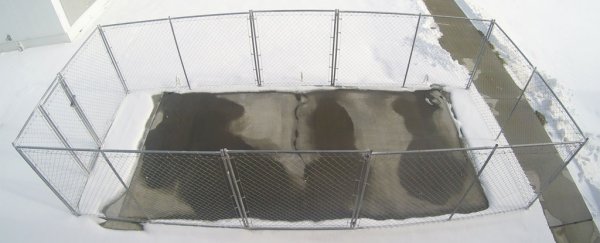A special blend of concrete that can de-ice roads and pavements without the need for chemicals uses electricity to melt away snow and sleet – and it could be coming to an airport near you soon.
The conductive concrete, developed by researchers at the University of Nebraska-Lincoln, is for the most part the same as regular concrete, but 20 percent of its ingredients aren't exactly standard: steel shavings and carbon particles, which give the mix enough conductivity that it can melt ice and snow while remaining safe to the touch.
Designed by civil engineer Chris Tuan, the conductive concrete is currently being assessed by the US Federal Aviation Administration (FAA), which is looking into the possibilities of incorporating the snow-melting surface into the tarmac of at least one major airport as part of a trial.
"To my surprise, they don't want to use it for the runways," said Tuan. "What they need is the tarmac around the gated areas cleared, because they have so many carts to unload – luggage service, food service, trash service, fuel service – that all need to get into those areas. They said that if we can heat that kind of tarmac, then there would be (far fewer) weather-related delays. We're very optimistic."
The concrete isn't just a problem-solver for flight delays. It's been in use since 2002 when Tuan and the Nebraska Department of Roads turned the Roca Spur Bridge into the world's first bridge with electrically conductive concrete's first bridge with electrically conductive concrete, thanks to 52 slabs that de-ice the length of its roadway. Tuan says this project remains the perfect example of how conductive concrete can be used to benefit infrastructure.
"Bridges always freeze up first, because they're exposed to the elements on top and bottom," said Tuan. "It's not cost-effective to build entire roadways using conductive concrete, but you can use it at certain locations where you always get ice or have potholes."
Whereas salt and de-icing chemicals can lead to concrete corrosion or contaminating groundwater, Tuan believes conductive concrete doesn't pose any environmental hazards, and it's cheaper to implement too. The amount of power used to thermally de-ice the Roca Spur Bridge during a three-day storm would cost around US$250, according to Tuan, which he says is several times less than a truckload of de-icing chemicals.
One of the side benefits of the technology is that it by including a mineral called magnetite to replace the limestone and sand used in typical concrete, the conductive mix also manages to shield against electromagnetic waves, including the radio-frequency waves used by mobile phones. This could make the mixture of interest to those concerned about industrial espionage at sensitive sites.
In the meantime, Tuan is enjoying the benefits of conductive concrete at a rather more ordinary location. "I have a patio in my backyard that is made of conductive concrete," he said. "So I'm practising what I preach."
